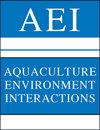大规模养殖活动对亚热带海水养殖湾海水碳酸盐系统和海气CO2通量的影响
IF 2.5
2区 农林科学
Q2 FISHERIES
引用次数: 4
摘要
本研究以2016年春季(3 - 5月)中国典型的亚热带水产养殖海湾神澳湾为研究区域,对其海水碳酸盐系统参数和海气CO2通量(FCO2)的变化进行了研究。在3个不同的养殖区域(鱼、牡蛎和海藻)和海湾口附近的非养殖区域每月测量海水碳酸盐系统和FCO2相关参数。结果表明,海水碳酸盐系统受培养种生物过程的影响显著。牡蛎区总碱度明显低于鱼类和海藻区,主要原因是牡蛎的钙化过程。溶解无机碳(DIC)和CO2分压(pCO2)在鱼类区最高,牡蛎区次之,非养殖区次之,海藻区最低。牡蛎和鱼类可以通过释放营养物质间接影响DIC和pco2,这些营养物质促进海藻和浮游植物的生长,从而促进光合作用CO2的固定。由于这些原因,神鳌湾在春季作为一个潜在的CO2汇,平均FCO2在- 1.2到- 4.8 mmol m - 2 d - 1之间。海藻区的CO2固定是CO2通量的最大贡献者,约占整个海湾总CO2汇容量的58%。这些结果表明,大规模海水养殖活动对沈坳湾的碳酸盐系统和FCO2有显著影响。通过扩大海藻的养殖面积,可以获得更高的CO2吸收能力。本文章由计算机程序翻译,如有差异,请以英文原文为准。
Impacts of large-scale aquaculture activities on the seawater carbonate system and air-sea CO2 flux in a subtropical mariculture bay, southern China
In this study, the variations of the seawater carbonate system parameters and air−sea CO2 flux (FCO2) of Shen’ao Bay, a typical subtropical aquaculture bay located in China, were investigated in spring 2016 (March to May). Parameters related to the seawater carbonate system and FCO2 were measured monthly in 3 different aquaculture areas (fish, oyster and seaweed) and in a non-culture area near the bay mouth. The results showed that the seawater carbonate system was markedly influenced by the biological processes of the culture species. Total alkalinity was significantly lower in the oyster area compared with the fish and seaweed areas, mainly because of the calcification process of oysters. Dissolved inorganic carbon (DIC) and CO2 partial pressure (pCO2) were highest in the fish area, followed by the oyster and non-culture areas, and lowest in the seaweed area. Oysters and fish can have indirect influences on DIC and pCO2by releasing nutrients, which facilitate the growth of seaweed and phytoplankton and therefore promote photosynthetic CO2 fixation. For these reasons, Shen’ao Bay acts as a potential CO2 sink in spring, with an average FCO2 ranging from −1.2 to −4.8 mmol m −2 d−1. CO2 fixation in the seaweed area was the largest contributor to CO2 flux, accounting for ca. 58% of the total CO2 sink capacity of the entire bay. These results suggest that the carbonate system and FCO2 of Shen’ao Bay were significantly affected by large-scale mariculture activities. A higher CO2 sink capacity could be acquired by extending the culture area of seaweed.
求助全文
通过发布文献求助,成功后即可免费获取论文全文。
去求助
来源期刊

Aquaculture Environment Interactions
FISHERIES-MARINE & FRESHWATER BIOLOGY
CiteScore
4.90
自引率
13.60%
发文量
15
审稿时长
>12 weeks
期刊介绍:
AEI presents rigorously refereed and carefully selected Research Articles, Reviews and Notes, as well as Comments/Reply Comments (for details see MEPS 228:1), Theme Sections and Opinion Pieces. For details consult the Guidelines for Authors. Papers may be concerned with interactions between aquaculture and the environment from local to ecosystem scales, at all levels of organisation and investigation. Areas covered include:
-Pollution and nutrient inputs; bio-accumulation and impacts of chemical compounds used in aquaculture.
-Effects on benthic and pelagic assemblages or processes that are related to aquaculture activities.
-Interactions of wild fauna (invertebrates, fishes, birds, mammals) with aquaculture activities; genetic impacts on wild populations.
-Parasite and pathogen interactions between farmed and wild stocks.
-Comparisons of the environmental effects of traditional and organic aquaculture.
-Introductions of alien species; escape and intentional releases (seeding) of cultured organisms into the wild.
-Effects of capture-based aquaculture (ranching).
-Interactions of aquaculture installations with biofouling organisms and consequences of biofouling control measures.
-Integrated multi-trophic aquaculture; comparisons of re-circulation and ‘open’ systems.
-Effects of climate change and environmental variability on aquaculture activities.
-Modelling of aquaculture–environment interactions; assessment of carrying capacity.
-Interactions between aquaculture and other industries (e.g. tourism, fisheries, transport).
-Policy and practice of aquaculture regulation directed towards environmental management; site selection, spatial planning, Integrated Coastal Zone Management, and eco-ethics.
 求助内容:
求助内容: 应助结果提醒方式:
应助结果提醒方式:


